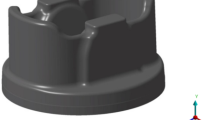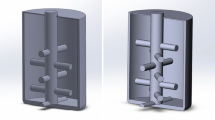Abstract
The pulp-molding product is a new degradable and pollution-free packaging material replacing traditional packaging materials. Countries are strongly recommending that pulp-molding machines are mainly used to produce pulp-molding products. The stability, efficiency, and rapidity of its products’ molding and processing quality are largely controlled by the structural dynamic mechanics of the molding machine frame. Its equipment’s dynamic performance is measured by the 1st-order natural frequency. The pulp-molding machine frame was taken as an example for optimizing the design and investigating the dynamic performance in the work. Based on finite elements, the beam structure was divided into finite elements, and the global independent generalized displacement coordinates of equipment were extracted using multi-point constraint elements. The global independent generalized displacement coordinates and the Lagrange equation were used to establish the device’s elastic dynamic model. Besides, the correctness of the theoretical model was verified by the finite element method. Finally, the first natural frequency was taken as the optimization design goal, and the particle swarm optimization algorithm was utilized to optimize the section size of the beam in equipment. The results could optimize the molding machine’s design and analyze the dynamic performance at the pre-design stage.





Similar content being viewed by others
Abbreviations
- M e :
-
Element mass matrix
- K e :
-
Element stiffness matrix
- L K b :
-
Stiffness matrix of the beam element in the local coordinate frame
- K b :
-
Stiffness matrix of the beam element in the global coordinate frame
- \({\varvec {K}}_{bi}^{g}\) :
-
Stiffness contribution matrix of the ith beam element to the machine
- Δ ei :
-
Linear displacement of element node i
- φ ei :
-
Angular displacement of element node i
- E ke :
-
Kinetic energy of the beam element
- f i :
-
The ith-order natural frequency in Hz
- U :
-
Global independent displacement coordinates
- M :
-
Overall mass matrix
- K :
-
Overall stiffness matrix
- L M b :
-
Mass matrix of the beam element in the local coordinate frame
- M b :
-
Mass matrix of the beam element in the global coordinate frame
- \({\varvec {M}}_{bi}^{g}\) :
-
Mass contribution matrix of the ith beam element to the machine
- u e :
-
Element-nodal-displacement column vector
- E k :
-
Kinetic energy of the machine
- E pe :
-
Potential energy of the beam element
- E p :
-
Potential energy of the machine
- ω i :
-
The ith-order circular frequency in rad/s
References
Curling SF, Laflin N, Davies GM et al (2017) Feasibility of using straw in a strong, thin, pulp moulded packaging material. Ind Crop Prod 97:395–400
Hoffmann J (2000) Compression and cushioning characteristics of moulded pulp packaging. John Wiley & Sons Ltd 13(5):211–220
Yang C, Ye W, Li QC (2022) Review of the performance optimization of parallel manipulators. Mech Mach Theory 170:104725
Zhang F, Lijuan W, Xingye A et al (2020) Improving sizing performance of middle layer of liquid packaging board containing high-yield pulp. Ind Crop Prod 150
Pham MT, Teo TJ, Song HY (2017) Synthesis of multiple degrees-of-freedom spatial-motion compliant parallel mechanisms with desired stiffness and dynamics characteristics. Precis Eng 47:131–139
Wu L, Wang G, Liu H et al (2018) An approach for elastodynamic modeling of hybrid robots based on substructure synthesis technique. Mech Mach Theory 123:124–136
Zhao Y, Gao F, Dong X et al (2011) Dynamics analysis and characteristics of the 8-PSS flexible redundant parallel manipulator. Robot Comput Integr Manuf 27(5):918–928
Liu SZ, Yu YQ, Su LY et al (2008) Dynamic modeling and frequency characteristic analysis of a 3-RRS flexible parallel robot. Chin Mech Eng 10:1219–1224
Liu SZ, Zhu ZC, Yu YQ et al (2011) Frequency characteristic analysis of spatial rigid-flexible coupled parallel mechanism system. J Mech Eng 47(23):39–48
Sheng L, Li W, Wang Y et al (2019) Rigid-flexible coupling dynamic model of a flexible planar parallel robot for modal characteristics research. Adv Mech Eng 11(1):1–10
Zhang X, Mills JK, Cleghorn WL (2007) Dynamic modeling and experimental validation of a 3-PRR parallel manipulator with flexible intermediate links. J Intell Rob Syst 50(4):323–340
Jia XH, Tian YL, Zhang DW (2010) Dynamic analysis of 3-PRR flexible parallel mechanism. Trans Chin Soc Agric Mach 41(10):199–203
Yang C, Li Q, Chen Q (2021) Natural frequency analysis of parallel manipulators using global independent generalized displacement coordinates. Mech Mach Theory 156:104145
Chen Q, Yang C (2021) Hybrid algorithm for multi-objective optimization design of parallel manipulators. Appl Math Model 98:245–265
Wu G (2017) Optimal structural design of a biglide parallel drill grinder. Int J Adv Manuf Technol 90(9–12):2979–2990
Wu G, Bai S, Hjornet P (2016) Architecture optimization of a parallel Schonflies-Motion Robot for pick-and-place applications in a predefined workspace. Mech Mach Theory 106:148–165
Sun T, Lian B (2018) Stiffness and mass optimization of parallel kinematic machine. Mech Mach Theory 120:73–88
Yun Y, Li Y (2011) Optimal design of a 3-PUPU parallel robot with compliant hinges for micromanipulation in a cubic workspace. Robot Comput Integr Manuf 27(6):977–985
Wang H, Zhang L, Chen G et al (2017) Parameter optimization of heavy-load parallel manipulator by introducing stiffness distribution evaluation index. Mech Mach Theory 108:244–259
Zhang J, Zhao YQ, Jin Y (2016) Elastodynamic modeling and analysis for an Exechon parallel kinematic machine. J Manuf Sci E T ASME 138(3):031011:1–14
Acknowledgements
The authors acknowledge the Horizontal Topic: Finite Element Analysis and Design Optimization of Key Components of Paper-Plastic Equipment (grant no. 00520104).
Funding
The work was supported by Horizontal Topic: Finite Element Analysis and Design Optimization of Key Components of Paper-Plastic Equipment (grant no. 00520104).
Author information
Authors and Affiliations
Contributions
Yaping Gong in charge of research ideas proposed constructive discussions; Junbin Lou analyzed and prepared the manuscript.
Corresponding author
Ethics declarations
Ethics approval
Not applicable.
Consent for publication
The manuscript is approved by all authors for publication; all authors listed have approved the manuscript that is enclosed.
Conflict of interest
The authors declare no competing interests.
Additional information
Publisher's Note
Springer Nature remains neutral with regard to jurisdictional claims in published maps and institutional affiliations.
Rights and permissions
About this article
Cite this article
Lou, J., Gong, Y. Dynamic performance analysis and optimization of pulp-molding machine frames. Int J Adv Manuf Technol 122, 209–217 (2022). https://doi.org/10.1007/s00170-022-09279-w
Received:
Accepted:
Published:
Issue Date:
DOI: https://doi.org/10.1007/s00170-022-09279-w




